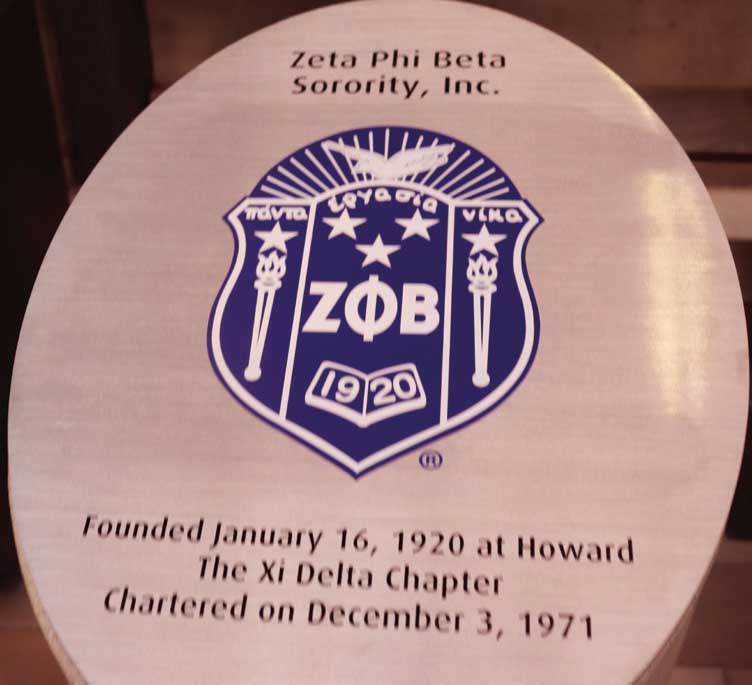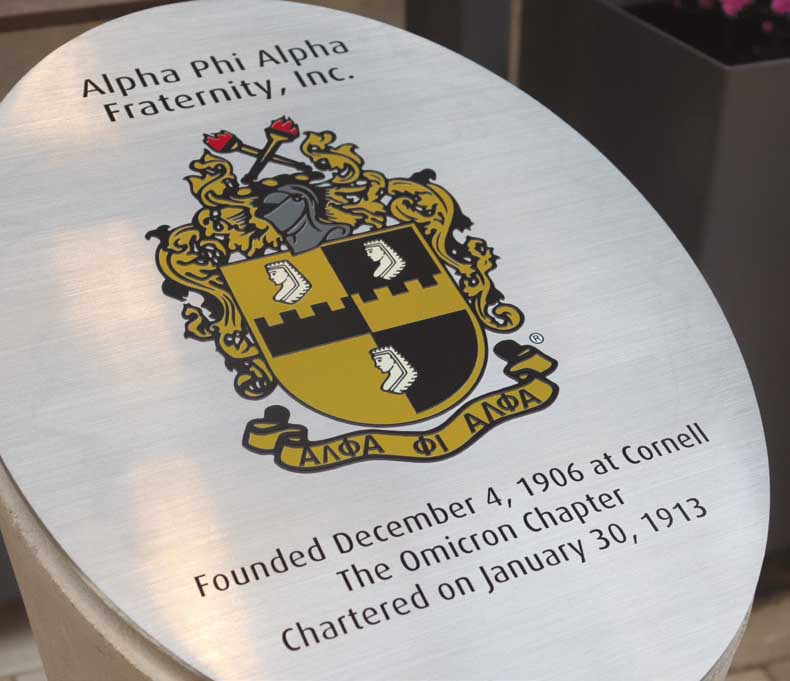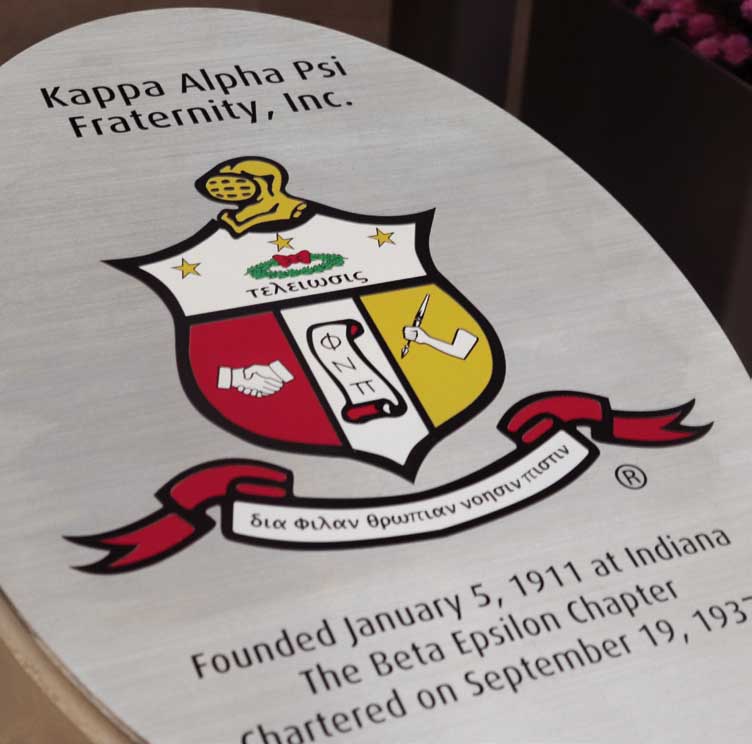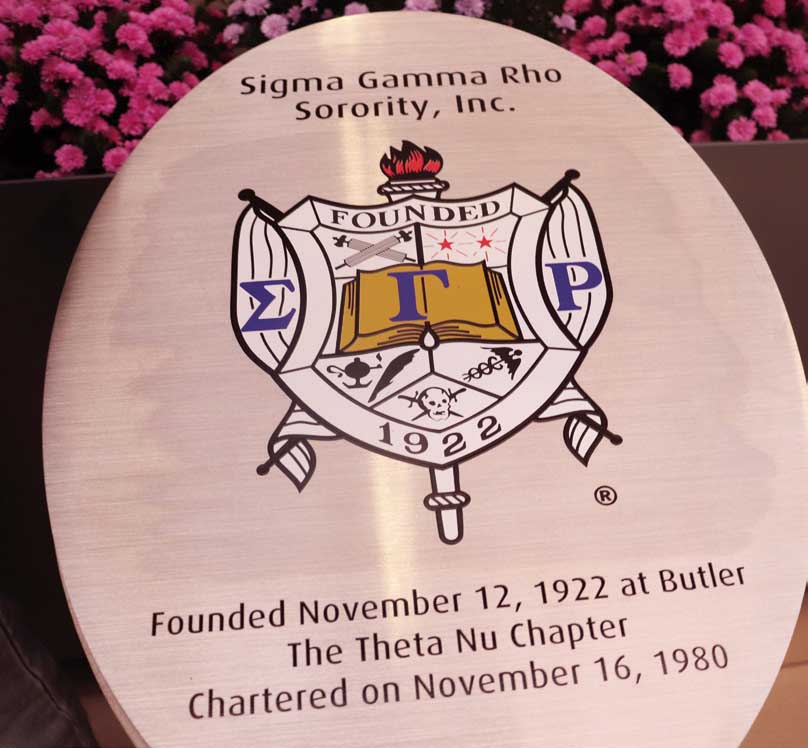LONGTIME MEMBERS of Delta Sigma Theta Sorority, Inc.—Diana Jaden, Dr. Tiffany Lewis, Phyllis Johnson, Lafay Pinchback, Valerie Njie, Tracey Gillard. They are standing next to the plot honoring the Deltas, which is now cemented on the University of Pittsburgh campus. (Photo by Rob Taylor Jr.)
Black Greek organizations celebrate plot unveiling placed in the heart of campus
Part of Kenyon Bonner’s job as Vice Provost of Student Affairs at the University of Pittsburgh is to ask students about why they chose to come to Pitt, and their overall student experience.
One of those students’ responses, about five years ago, stunned Bonner. The student said when they were visiting Pitt as an incoming freshman, they had no idea if Pitt had historically African American fraternities and sororities on its campus.
At that moment, Bonner said: “We gotta do something about this.”
More than 1,000 people, mostly members of the “Divine Nine” Black Greek letter organizations, on Sept. 25 congregated at the heart of Pitt’s campus in Oakland, the Schenley Quadrangle, to watch the highly-anticipated unveiling of the Divine Nine Plot. After hearing from speakers such as Pitt Chancellor Patrick Gallagher, National Pan Hellenic Council National President Vanetta Cheeks Reeder and Pitt Alumni President Valerie Njie, the lever was pulled and the sizable plot which was years in the making was unveiled to applause and admiration.
Plots are constructed to symbolically and physically represent each Black Greek letter organization’s presence on college campuses and to give alumni and current members a location for reflection and celebration. The plot at Pitt spans roughly 50 feet in length and 10 feet in height, complete with the iconic symbol of each organization, along with flowers and names of some of the contributors that helped make the $150,000 plot come to fruition.
“This is another way to make it very known to students that National Pan Hellenic Council organizations exist on this campus,” Bonner told the New Pittsburgh Courier in an exclusive interview after the unveiling.
Black Greek letter organizations “represent a time that we don’t forget,” Bonner added, “where we were on White college campuses and we didn’t feel welcomed. We didn’t feel like we belonged and it was hard to create that community and that cohesion, let alone to get students at these campuses but to keep them there. These organizations were birthed out of, ‘We need to do something that makes sure that we are successful in college.’”
Pitt is one of just a handful of Predominantly White Institutions that have a Divine Nine plot on its campus; the first of its kind in Western Pennsylvania. Some other PWIs that have plots include Duke University, Arizona State University and Wake Forest University. They’re pretty much a staple at HBCUs. It’s a good bet that the trend will continue of PWIs installing Divine Nine Plots on its campuses.
Chancellor Gallagher called the unveiling a “big, big moment for the university.”
He added: “These storied Greek organizations have created a bonded fellowship that for so many has been that home” for Black college students who, for decades, faced segregation and oppression. “This home was vitally important, and the importance hasn’t diminished.”
The organizations that comprise the Divine Nine are: Alpha Phi Alpha Fraternity, Inc. (founded in 1906, at Cornell University); Alpha Kappa Alpha Sorority, Inc. (1908, Howard University); Kappa Alpha Psi Fraternity, Inc. (1911, Indiana University); Omega Psi Phi Fraternity, Inc. (1911, Howard University); Delta Sigma Theta Sorority, Inc. (1913, Howard University); Phi Beta Sigma Fraternity, Inc. (1914, Howard University); Zeta Phi Beta Sorority, Inc. (1920, Howard University); Sigma Gamma Rho Sorority, Inc. (1922, Butler University); Iota Phi Theta Fraternity, Inc. (1963, Morgan State University).
At Pitt, the first Black Greek letter organization was Alpha Phi Alpha Fraternity, Omicron Chapter, in 1913. It’s the third-oldest fraternity or sorority chapter at Pitt. Then came the Mu Chapter of Delta Sigma Theta Sorority in 1921. Six other Black Greek organizations have been established on Pitt’s campus (Alpha Kappa Alpha Sorority, Kappa Alpha Psi Fraternity, Omega Psi Phi Fraternity, Phi Beta Sigma Fraternity, Sigma Gamma Rho Sorority, Zeta Phi Beta Sorority). Iota Phi Theta Fraternity does not have a chapter at the university, though it is represented on the Pitt plot and has chapters at other local universities like Duquesne and Indiana University of Pennsylvania.
Chancellor Gallagher was elated that the plot is placed in such a central location on campus, where thousands of students pass, “so they can see the incredible role that these fraternities and sororities have played at the University of Pittsburgh.”
Reeder, who attended Allderdice High School, studied nursing at Pitt and became a member of Sigma Gamma Rho Sorority; its Theta Nu Chapter was created in 1980 and Reeder joined a few years later. As the president of the National Pan Hellenic Council, few are bigger champions of Black Greek letter organizations than Reeder. She called the unveiling “historical” and “meaningful.”
“Culturally, we’re connected as these Black Greek letter organizations had to form when we were not invited to the other places,” Reeder told the Courier. “…For (current and future students) to know that they’re (Divine Nine organizations) officially here and they have a history, and a place, is not just marketing for the university, but adding to the diversity and the enrichment of the culture.”
Reeder said while academics play an important role in a student’s choice where to attend college, one cannot forget about the social impact. Oftentimes, being a member of a Black Greek organization runs in the family — a student’s mother may be, say, an AKA or Delta, and that student may choose one school over another simply because there is an AKA or Delta chapter at that school.

OMEGA PSI PHI FRATERNITY, INC. — Pitt Vice Provost of Student Affairs Kenyon Bonner, Bobby Shoes, Larry Meadows. Pictured below is the Omega Psi Phi Fraternity portion of the Pitt Divine Nine Plot. (Photos by Rob Taylor Jr.)


DAVID WILLIAMS, charter member for the Eta Nu Chapter of Iota Phi Theta Fraternity, Inc., pointing to his name displayed above on the plot for the organization.
For Bonner, he always wanted to be a Que (Omega Psi Phi Fraternity). But the school he attended as an undergraduate, Washington & Jefferson College, did not have an Omega Psi Phi chapter. Following his completion of graduate school at Kent State University, he joined Omega Psi Phi in Canton, Ohio.

LONGTIME MEMBERS of Alpha Kappa Alpha Sorority, Inc., Emma Lucas Darby and Toni Kendrick, stand next to the plot honoring the AKAs, which is now cemented on the University of Pittsburgh campus. (Photo by Rob Taylor Jr.)

ALPHA KAPPA ALPHA SORORITY, INC. — Kayla King Scott, Lisa Stewart, Ruthie Walker, Tamara Butler, Kelli Ware, Erica Givner.
When one graduates from college and enters the “real world,” Black Greek organizations remain in a person’s DNA. You’ll find the organizations committed to community service projects throughout a city or region, and being part of an organization helps with professional networking. Yes, it’s true — sometimes a person gets hired because they are, say, an Alpha, and the person doing the hiring is also an Alpha. An example of true brotherhood.

PHI BETA SIGMA FRATERNITY, INC.—EDGAR UNTHANK, ANGELO REEDER
Following the unveiling, each organization had its turn to take photos of its portion of the plot. Those in attendance seemed to take pride in knowing that the plot not only represents what Black Greek organizations have contributed to Pitt’s campus and its students, but that current and future students know that Pitt and the Schenley Quad is a place where they belong.

THOMAS BROOKS, who joined Alpha Phi Alpha Fraternity, Inc., while a student at Pitt in the mid-’80s.
Thomas Brooks certainly concurred. He’s a 1988 Pitt graduate who joined Alpha Phi Alpha Fraternity as an undergrad. He was there to help pull the lever to unveil the plot, calling it a “big moment for the university and for the African American community.”
Brooks, the celebrated author and public speaker, added: “If we can do more things like this to give Black students a sense of belongingness and connection with the university and the community, and the legacy in all that the Divine Nine has done, I think it’s all good for Pittsburgh and the region.”

IOTA PHI THETA FRATERNITY, INC. — MITCHELL HUTT, TERRY ELLERBE

PART OF THE PLOT honoring Zeta Phi Beta Sorority, Inc. The Zetas will be featured in the Oct. 6 Courier edition for its 50th anniversary of the Xi Delta Chapter at Pitt.

PART OF THE PLOT honoring Alpha Phi Alpha Fraternity, Inc.

PART OF THE PLOT honoring Kappa Alpha Psi Fraternity, Inc.

PART OF THE PLOT honoring Sigma Gamma Rho Sorority, Inc.